Silk Road Travelogue by Ali Karim: (2) More of Turpan and Historic Kashgar
BY ALI KARIM
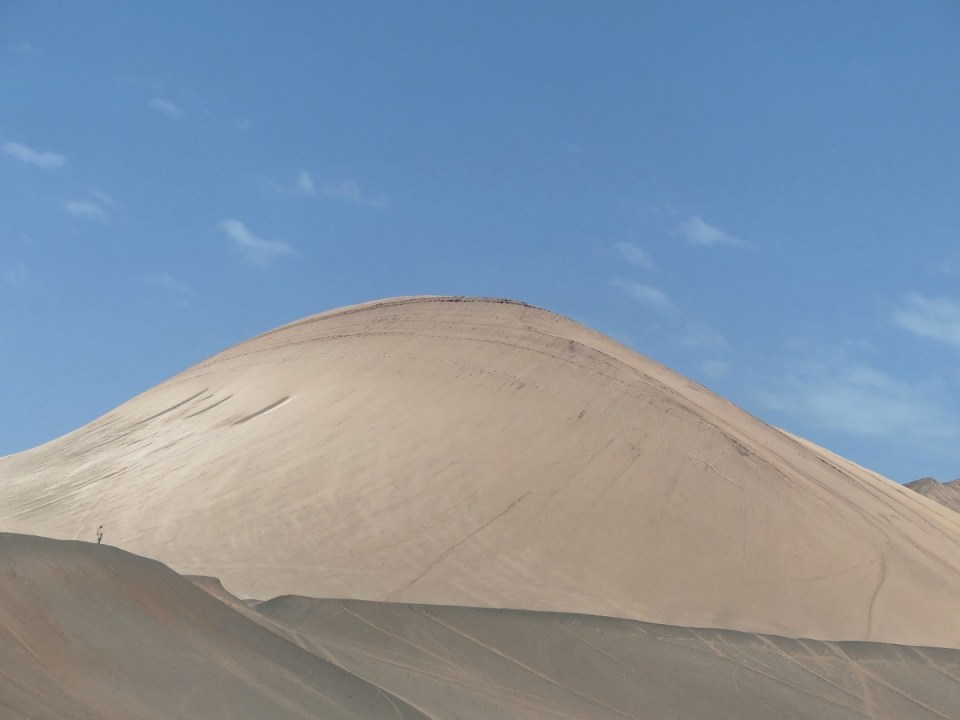 A magnificent desert landscape outside Turpan. Photo: Ali Karim. Copyright.
A magnificent desert landscape outside Turpan. Photo: Ali Karim. Copyright.
In this second installment of my multi-part travelogue on the Silk Road, I continue with more photos of my visit with my wife Dilshad to Turpan, a desert oasis in the Xinjiang, and then travel 1400 kms to Kashgar, another historical city on the ancient Silk Road which is famous for its daily bazaar crammed with foods, spices and clothing of all kinds. Our three-and-a-half-week trip to the Silk Road was fabulous and we highly recommend that everyone do this trip if they can. Please feel free to write to me by contacting the editor of this blog at Simerg@aol.com or by becoming my Facebook friend at https://www.facebook.com/ali.karim.10485.
(If you missed my first installment, please read it at Silk Road Travelogue by Ali Karim: (1) Shanghai, Urumqi and Turpan).
More Turpan…Then Kashgar
(Recap: At the end of my first installment, I mentioned how Dilshad and I went to a highly recommended Uyghur restaurant in Turpan. When we arrived at the restaurant it was fully packed! We were led by the hosts to a banquet hall where a 6-year-old girl’s birthday party was underway. We were most kindly asked to stay for the party. This gesture will never be forgotten by us. We enjoyed the lively event which had plenty of food, and entertainment for everyone as well as some scintillating dancing (see the video). We left the party at around 11 pm. after a memorable evening).
Video from the 1st installment of some great dancing at a birthday party in Turpan
On the following morning, Tariq, our Uyghur guide, showed up in time to take us in his car to see multiple sites around Turpan. Tariq came up with an itinerary for the day that was impressive. He also spoke good English. How were we to say no!
 Ali and Dilshad Karim stayed at the Silk Road Lodges in Turpan, a nice caravanserai style B&B within vineyards. Photo: Ali Karim. Copyright.
Ali and Dilshad Karim stayed at the Silk Road Lodges in Turpan, a nice caravanserai style B&B within vineyards. Photo: Ali Karim. Copyright.
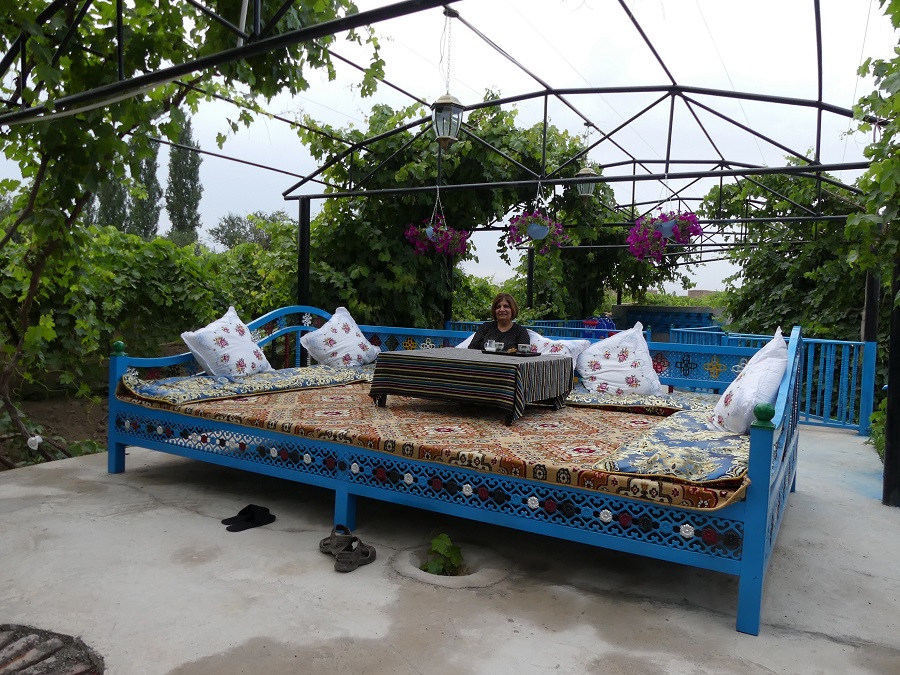 Dilshad relaxes at the grounds of the Silk Road Lodges, with grape vines in the back. Photo: Ali Karim. Copyright.
Dilshad relaxes at the grounds of the Silk Road Lodges, with grape vines in the back. Photo: Ali Karim. Copyright.
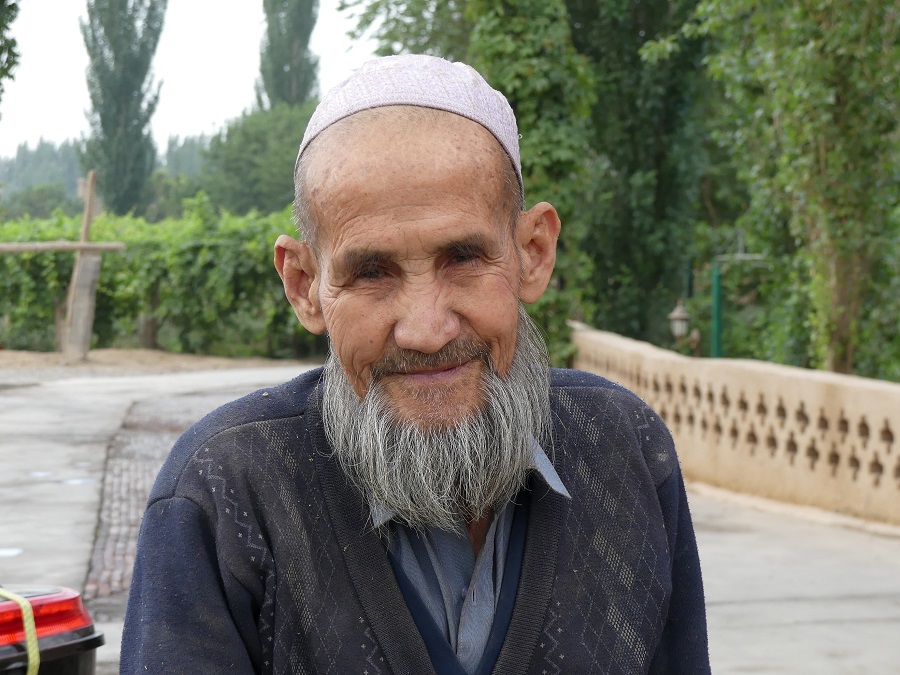 This 82 year old elder earns his livelihood in Turpan by doing manual work at the vineyards with other local residents. Photo: Ali Karim. Copyright.
This 82 year old elder earns his livelihood in Turpan by doing manual work at the vineyards with other local residents. Photo: Ali Karim. Copyright.
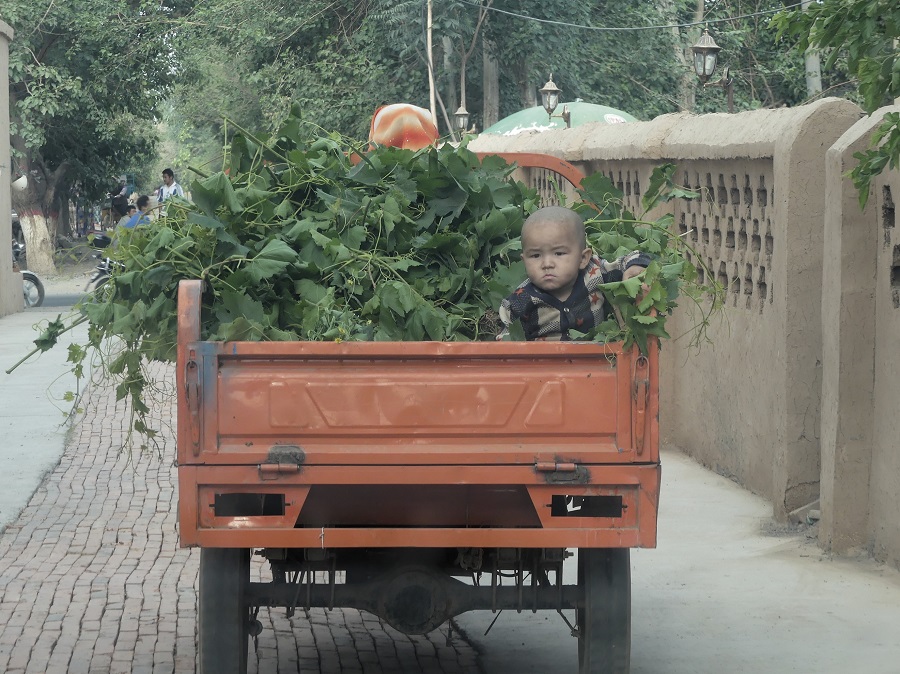 Grape vines are off to Turpan market in the morning, complete with a toddler in a 3-wheeler. Photo: Ali Karim. Copyright.
Grape vines are off to Turpan market in the morning, complete with a toddler in a 3-wheeler. Photo: Ali Karim. Copyright.
The area outside Turpan was a complete desert, with caked-up mud everywhere and not a single blade of grass or any scrub/brush vegetation anywhere, except where the land was irrigated, and there we saw lot and lots of grapes (for raisins and some for wine), water melon and other melons, squash etc growing. So it was brown everywhere and suddenly green where the land was irrigated.
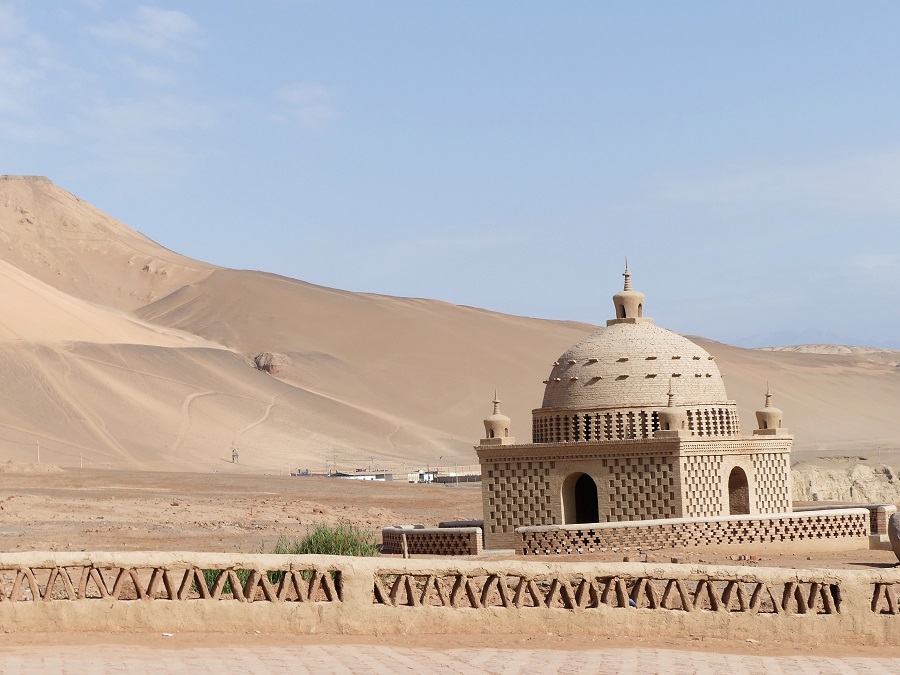 ….And a tiny mosque in the middle of a desert. Photo: Ali Karim. Copyright.
….And a tiny mosque in the middle of a desert. Photo: Ali Karim. Copyright.
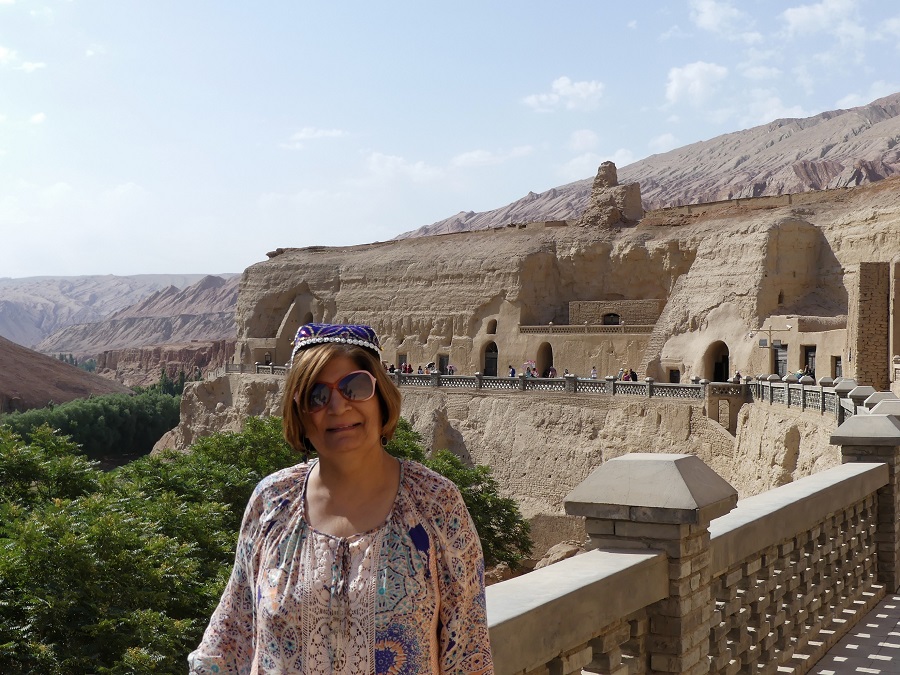 Dilshad along the site of the Thousand Buddha Caves. Photo: Ali Karim. Copyright.
Dilshad along the site of the Thousand Buddha Caves. Photo: Ali Karim. Copyright.
Of particular interest were the Thousand Buddha Caves, where paintings of Buddha’s were in multiple caves from before the Uyghur’s converted to Islam. Sadly, using Islam as an excuse, which they said did not allow human representation, many of the paintings had their eyes and faces disfigured, and statues destroyed, so unfortunately not much remains here to be seen. There were multiple other Buddha cave dwellings in this area that are being restored.
 Hundreds of grape drying huts in a barren landscape. Photo: Ali Karim. Copyright.
Hundreds of grape drying huts in a barren landscape. Photo: Ali Karim. Copyright.
Turpan is a well-known area for raisins and melons. Tariq took us to various places to show the grape growing and raisin-drying huts — everything was built with straw and mud adobe and this kept the houses cool in the hot summers.
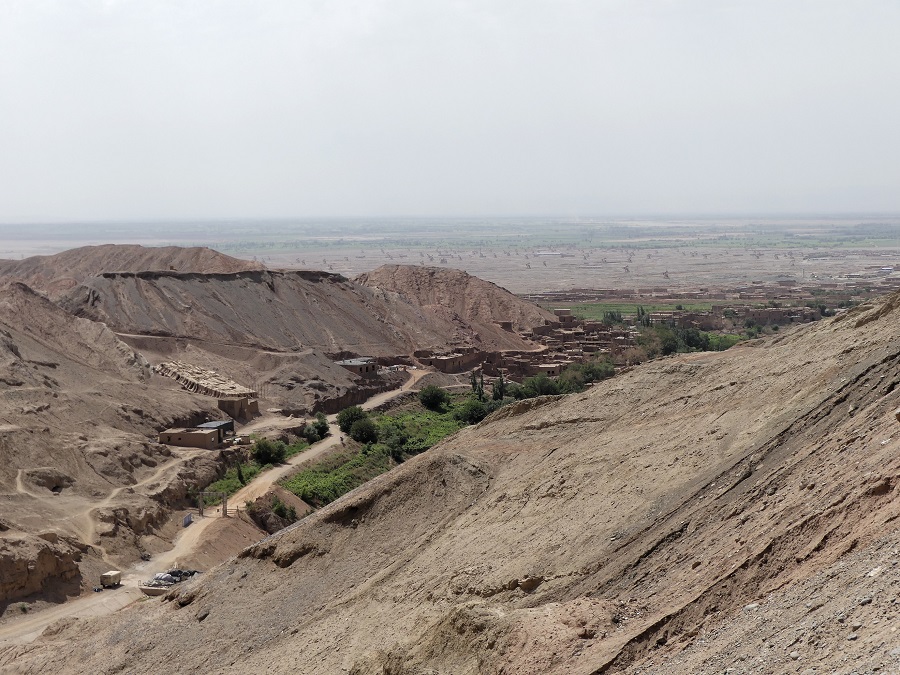 The Tuyuk Valley in Turpan. The greenery in this otherwise bleak landscape is due to the natural stream running through the village. Photo: Ali Karim. Copyright.
The Tuyuk Valley in Turpan. The greenery in this otherwise bleak landscape is due to the natural stream running through the village. Photo: Ali Karim. Copyright.
Another interesting stop was at Tuyuk village, which was an actual 2600-year-old working village where people still live and worked. The whole village is a UNESCO site, and one can walk around and look at the mud adobe house constructions everywhere built hundreds of years ago. The local mosque is also very old, and was closed as it was not prayer time. Nearby was a dargah or burial place of one of the first Islamic missionaries to convert locals to Islam in Uyghur country.
 Ali and Dilshad Karim pictured with renowned photographer Matthieu Paley (left), his wife (right) and their two children whom they met at their home in scenic Tuyuk valley in Turpan. Paley has taken incredible shots of this region over the past several years that have been published around the world including magazines such as the National Geographic. Photo: Ali Karim. Copyright.
Ali and Dilshad Karim pictured with renowned photographer Matthieu Paley (left), his wife (right) and their two children whom they met at their home in scenic Tuyuk valley in Turpan. Paley has taken incredible shots of this region over the past several years that have been published around the world including magazines such as the National Geographic. Photo: Ali Karim. Copyright.
It was also in Tuyuk that we ran into a world renowned photographer Matthieu Paley and his family who recognized us as Ismailis; they had actually worked for the Aga Khan Foundation in Hunza multiple times over the years, and Matthieu was a photographer for the agencies of the AKDN. What a small world!
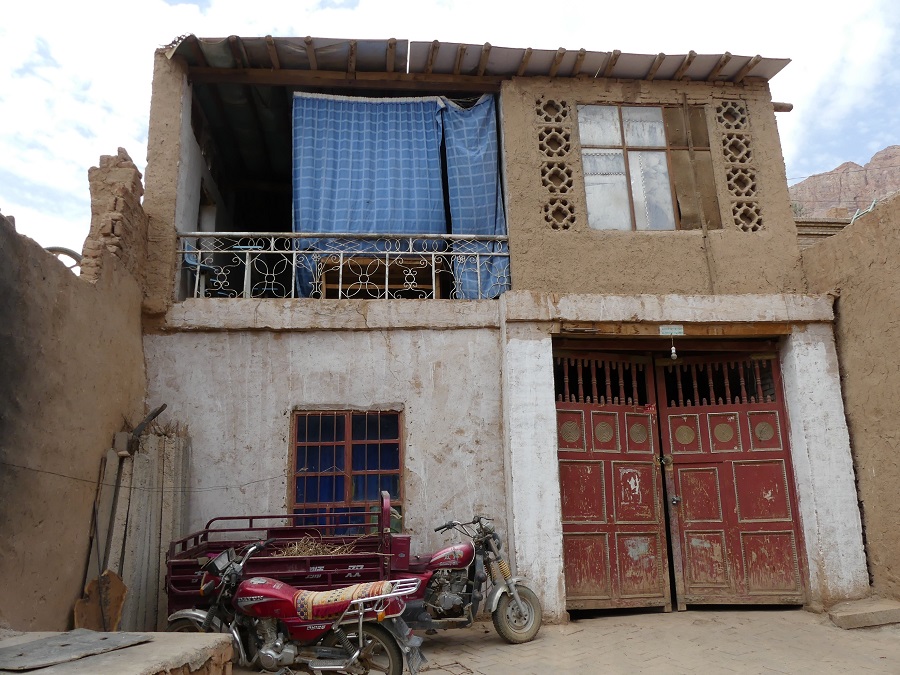 Exterior of a house in Tuyuk. Photo: Ali Karim. Copyright.
Exterior of a house in Tuyuk. Photo: Ali Karim. Copyright.
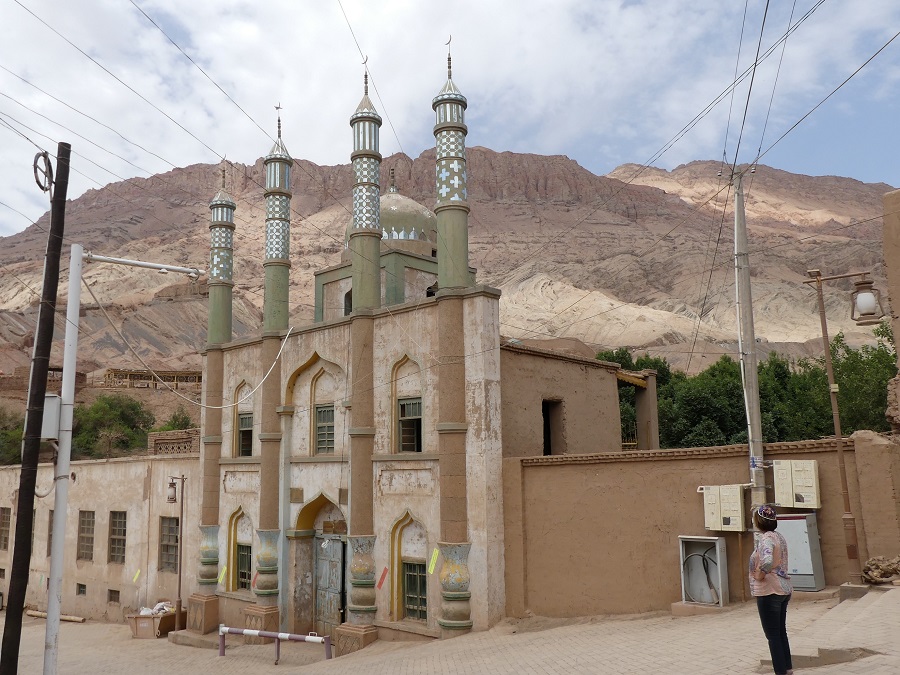 The local mosque in Tuyuk. Photo: Ali Karim. Copyright.
The local mosque in Tuyuk. Photo: Ali Karim. Copyright.
 A strapped toddler sleeps peacefully in his cradle. Photo: Ali Karim. Copyright.
A strapped toddler sleeps peacefully in his cradle. Photo: Ali Karim. Copyright.
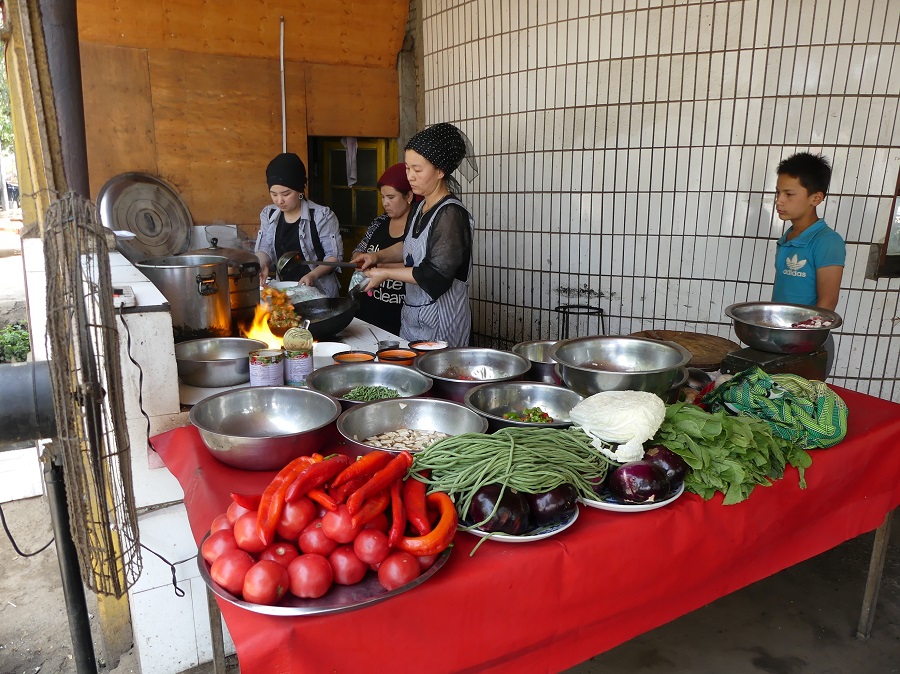 Road side restaurant in Gaochang , also called Kara-Khoja, that serves delicious vegetarian dishes as well as fatty lamb kebabs. Photo: Ali Karim. Copyright.
Road side restaurant in Gaochang , also called Kara-Khoja, that serves delicious vegetarian dishes as well as fatty lamb kebabs. Photo: Ali Karim. Copyright.
Lunch was at a roadside restaurant in the town of Kara-Khoja (“Black King”), near Turpan, which served up a delicious Uyghur dish of noodles and vegetables.
The best site for me was the Karez in Turpan. This is actually a man-made wonder which has not had any press. It is a man-made water channel system of over 5000 km of underground channels for getting water from mountain snows to the flat lands where people lived for water supply and irrigation, all over Xinjiang. Along the way, there are vertical shafts built every 10m or so to allow people to manually dig the underground channels. A huge underground water channel system manually built by the Uyghurs thousands of years ago. Quite an engineering feat.
 An explanation about a man-made wonder — the Karez water channel system of over 5000 kms of underground channels. Photo: Ali Karim. Copyright.
An explanation about a man-made wonder — the Karez water channel system of over 5000 kms of underground channels. Photo: Ali Karim. Copyright.
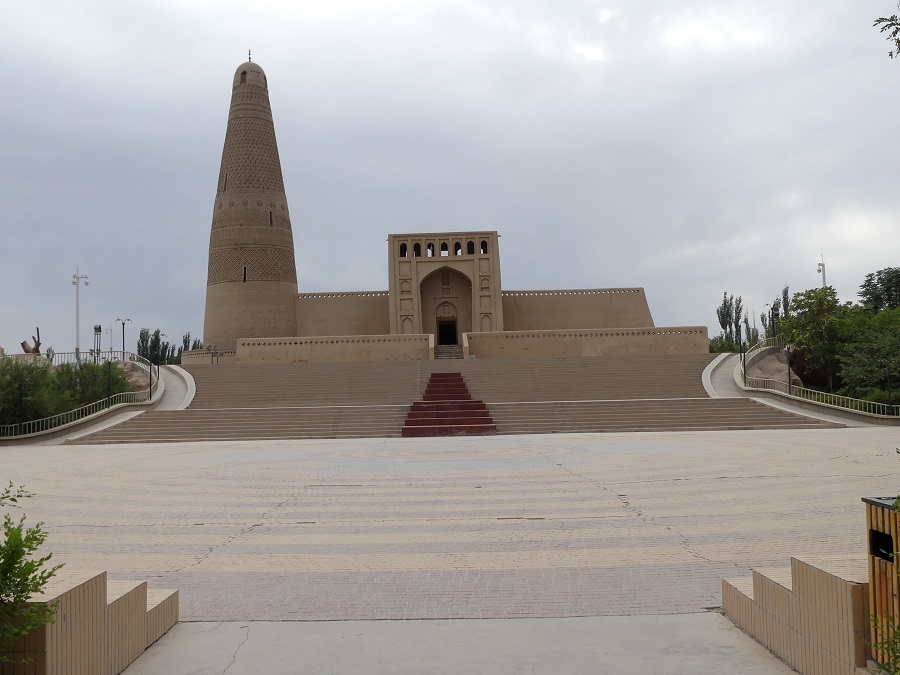 The impressive Emin mosque in Turpan, built of adobe. Most areas inside were off limits despite the high entrance fee, and there was little explanation of this site anywhere. Photo: Ali Karim. Copyright.
The impressive Emin mosque in Turpan, built of adobe. Most areas inside were off limits despite the high entrance fee, and there was little explanation of this site anywhere. Photo: Ali Karim. Copyright.
On the way back, after visiting the Emin mosque, Tariq took us to his mother-in-law’s house where we met his wife and daughter. He showed us the inside of their house and explained how the heating works. Since it gets cold here in winter, they have a wood or coal burning stove in each room, with the hot exhaust being circulated in pipes behind a brick enclosure in order to heat the room slowly overnight. The hot exhaust pipes then run under their beds which are raised wood platforms, with carpets and then a thin mattresses laid on top. The hot gas is then exhausted outside the room via a chimney over the roof. This smart scientific feat keeps the bed warm all night!
 Our tour guide Tariq’s wife and daughter, Meharaba, at his mother-in-laws home. Photo: Ali Karim. Copyright.
Our tour guide Tariq’s wife and daughter, Meharaba, at his mother-in-laws home. Photo: Ali Karim. Copyright.
____________________
Kashgar
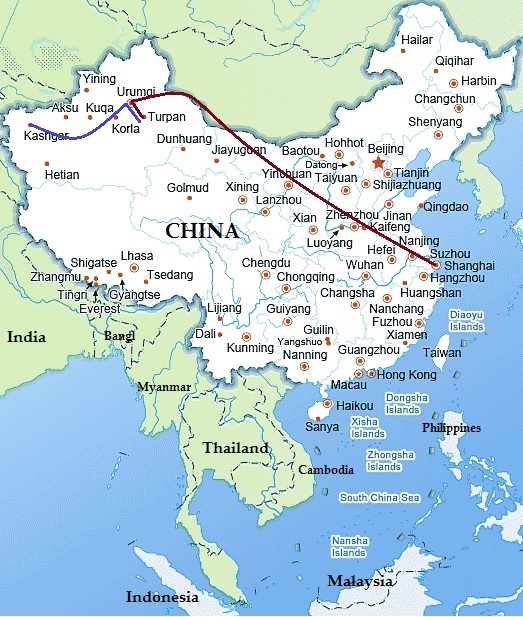 The first phase of our Silk Road journey – covered in the first installment of the travelogue – is denoted by the red line. Upon our arrival in China, we stayed for a few days in Shangai, and then took a 5-hour flight to Urumqi, in Xinjiang. We spent some time in Urumqi and then took a high speed train to Turpan. The second phase of our journey, described on this page, is denoted by the blue line. We visited several more sites in and around Turpan, and travelled back to Urumqi, again on the high speed train. From Urumqi we flew 1400 kms south-west to Kashgar.
The first phase of our Silk Road journey – covered in the first installment of the travelogue – is denoted by the red line. Upon our arrival in China, we stayed for a few days in Shangai, and then took a 5-hour flight to Urumqi, in Xinjiang. We spent some time in Urumqi and then took a high speed train to Turpan. The second phase of our journey, described on this page, is denoted by the blue line. We visited several more sites in and around Turpan, and travelled back to Urumqi, again on the high speed train. From Urumqi we flew 1400 kms south-west to Kashgar.
To go to Kashgar, we had to return to Urumqi. During our breakfast at the Silk Road Lodges we met another couple, Giulliame and Maggie Goudy, who were going on the same high-speed train as us to Urumqi, and then to the Urumqi airport for a flight to Kashgar. Since we had the same itinerary, we decided to car-pool with them. Guillame spoke Chinese, and that helped us a lot. We arrived at the Urumqi airport well ahead of the departure time, and Dilshad convinced the China Southern airlines staff to get us into an earlier flight, even though our tickets were not changeable.
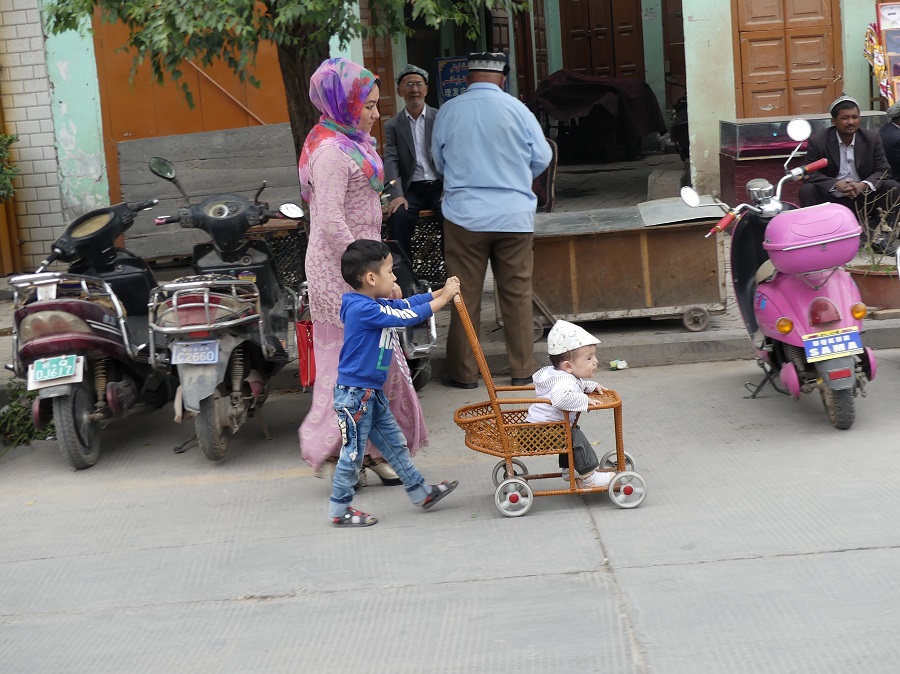 A young boy pushes a baby stroller in Kashgar. Photo: Ali Karim. Copyright.
A young boy pushes a baby stroller in Kashgar. Photo: Ali Karim. Copyright.
Once in Kashgar, we took a taxi with the Goudy’s, and they dropped us off at our hotel. We kept running into the couple in Kashgar, Tashkurgan and other places we went to. After checking in at the hotel, we decided to explore the town a little with Ablimit, our Uyghur guide in Kashgar.
Like Turpan, Kashgar is one of the few oases in this part of China where the Silk Road Caravans stopped along their journeys. Kashgar, especially, became a big trading center where Tajiks, Khirgiz, Khazaks, Uzbecs and other Europeans and Persians traded in this oasis stop on their way to and from China. Kashgar is a very old city, with a large (60-70%) Uyghur Muslim population (rest being Han imports).
The main mosque is Id Kah mosque, which is in the center of the old part of the city.
 Kashgar’s Id Kah mosque and the huge square in front of it. The 15th century mosque can accommodate up to 10,000 worshipers. Photo: Ali Karim. Copyright.
Kashgar’s Id Kah mosque and the huge square in front of it. The 15th century mosque can accommodate up to 10,000 worshipers. Photo: Ali Karim. Copyright.
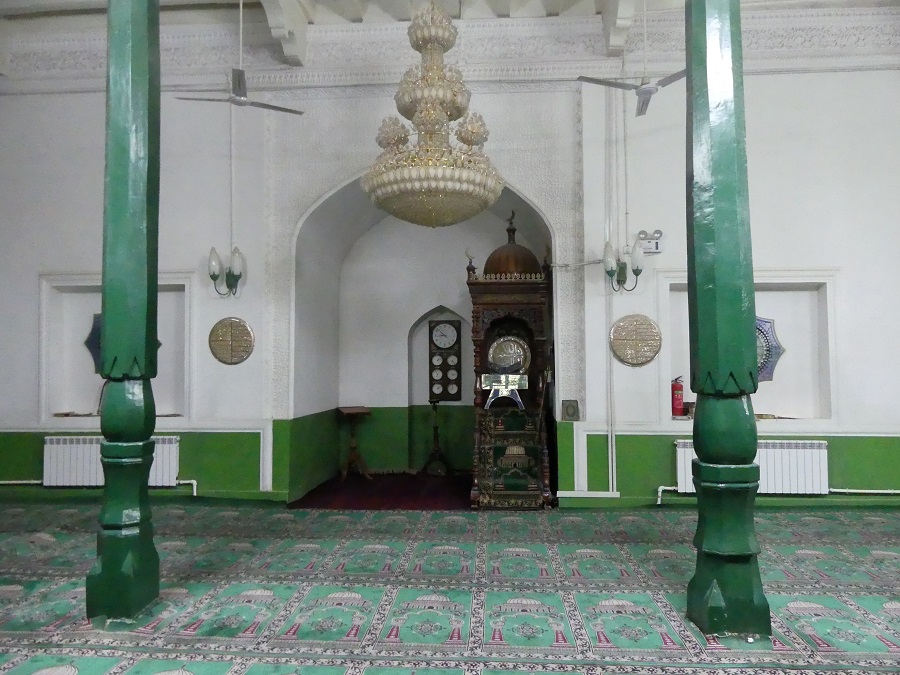 The simple interior of Id Kah mosque. Photo: Ali Karim. Copyright.
The simple interior of Id Kah mosque. Photo: Ali Karim. Copyright.
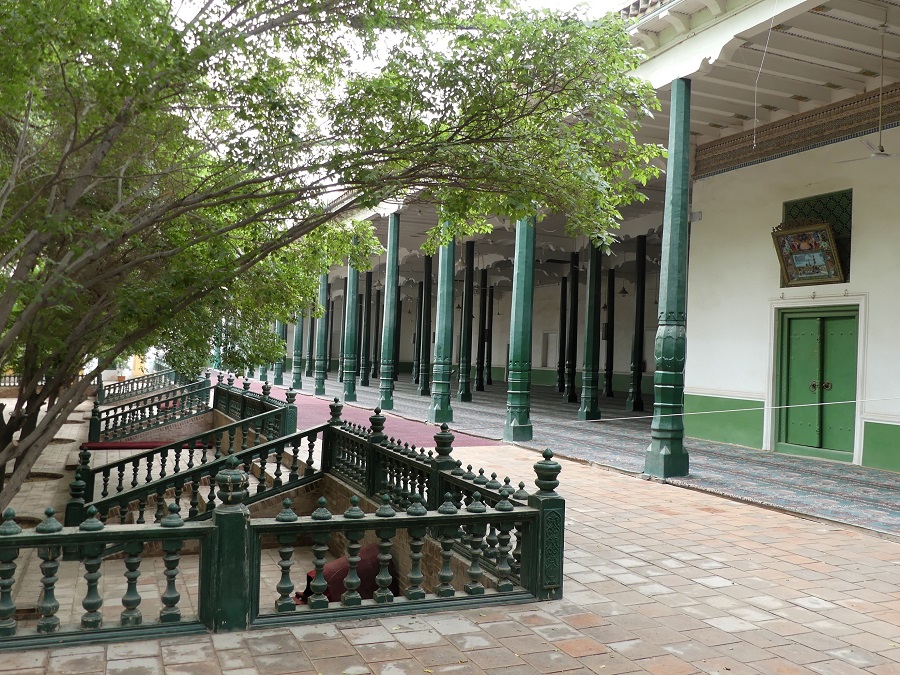 There is lots of space outside the main prayer hall of Id Kah mosque to accommodate thousands of faithfuls. Photo: Ali Karim. Copyright.
There is lots of space outside the main prayer hall of Id Kah mosque to accommodate thousands of faithfuls. Photo: Ali Karim. Copyright.
The old area of the city is where all the excitement was for us. The Chinese government took some part of the old town, and “modernized” it by building in better facilities — electricity, water, sanitation etc — and then renovated the exteriors to make it look like an old city (“new old city”). It was nicely done. However, it did not have the character of the true “old old city”.
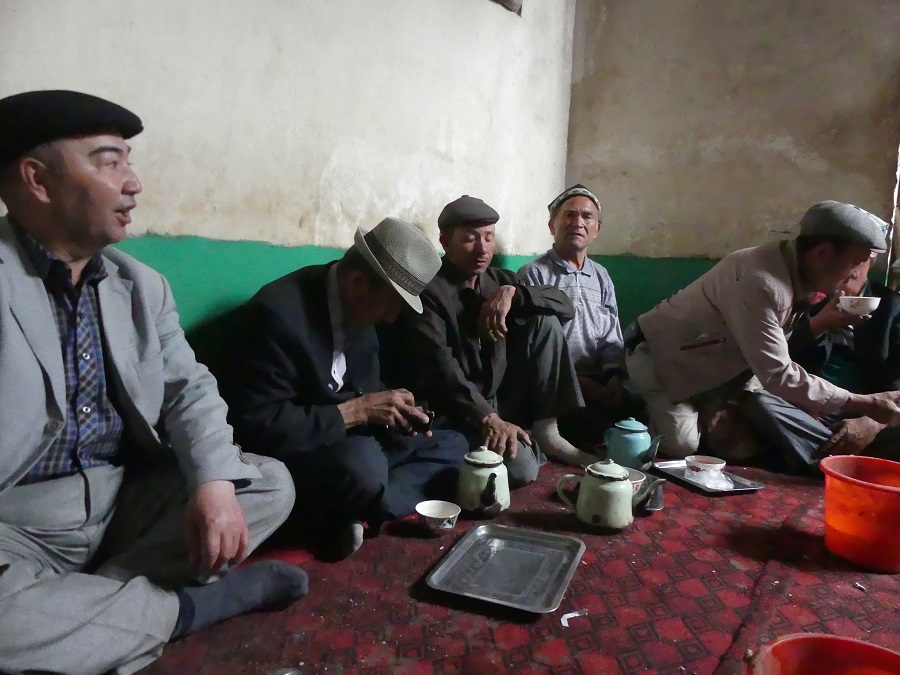 Traditional tea house in Kashgar where old men drink black tea, and discuss the day’s issues. Photo: Ali Karim. Copyright.
Traditional tea house in Kashgar where old men drink black tea, and discuss the day’s issues. Photo: Ali Karim. Copyright.
We spent time walking the “new” old city, and went to and old traditional tea house, where only old men sit down, drink light black tea (with leaves) and dunk hard rolls of bread into the tea and eat that. Among themselves, they discuss all kinds of daily events, and solve the world’s problems! Of course Dilshad was the only woman there, but was welcomed by the regulars.
We then went to the interesting night market. It only gets set up in the evening with multiple food stalls serving all kinds of local dishes.
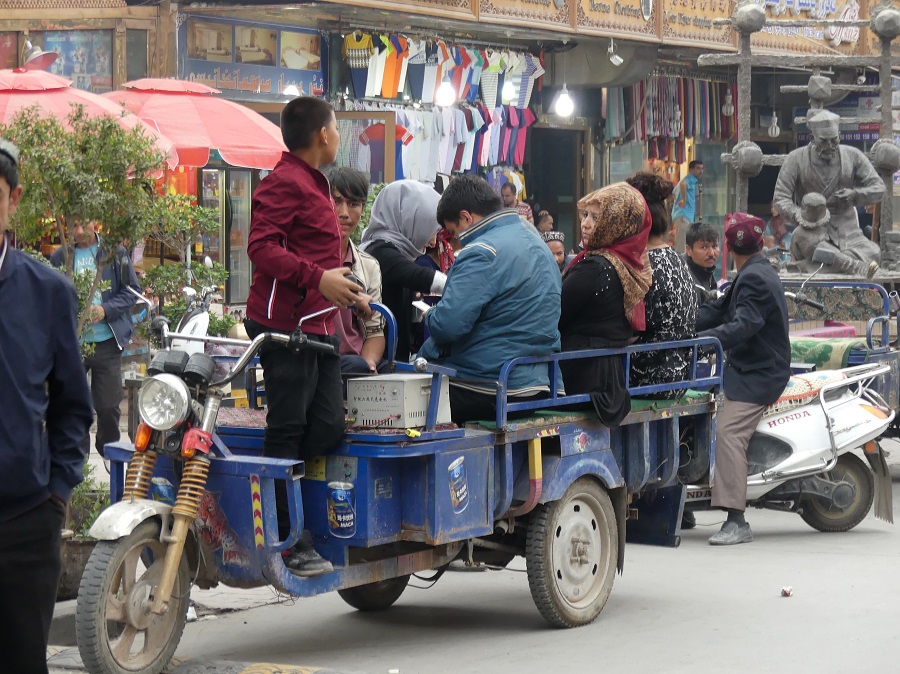 Kashgar’s vibrant night market. Photo: Ali Karim. Copyright.
Kashgar’s vibrant night market. Photo: Ali Karim. Copyright.
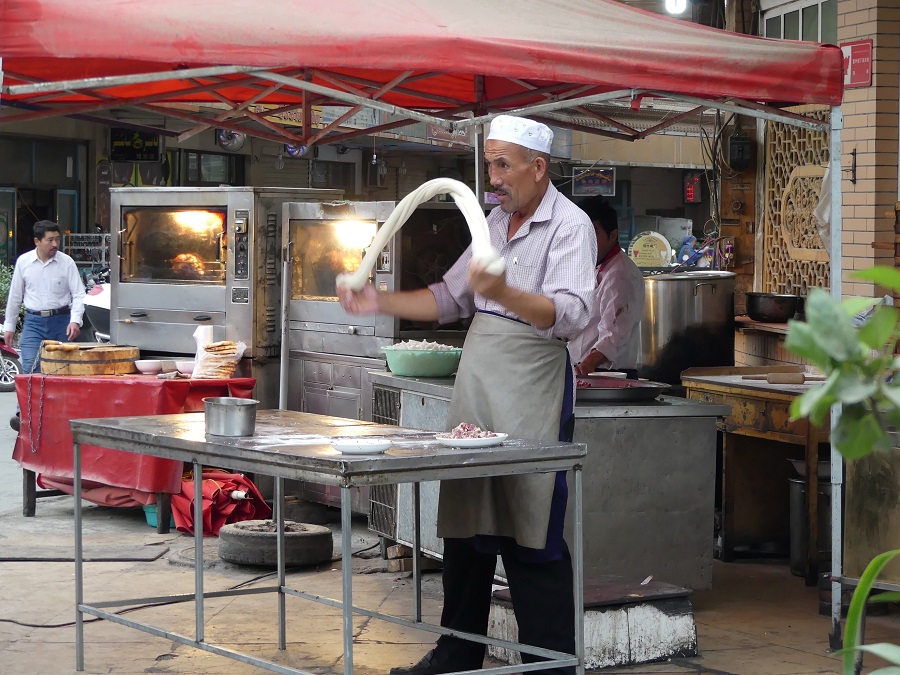 Fresh noodle making at Kashgar’s night market. Photo: Ali Karim. Copyright.
Fresh noodle making at Kashgar’s night market. Photo: Ali Karim. Copyright.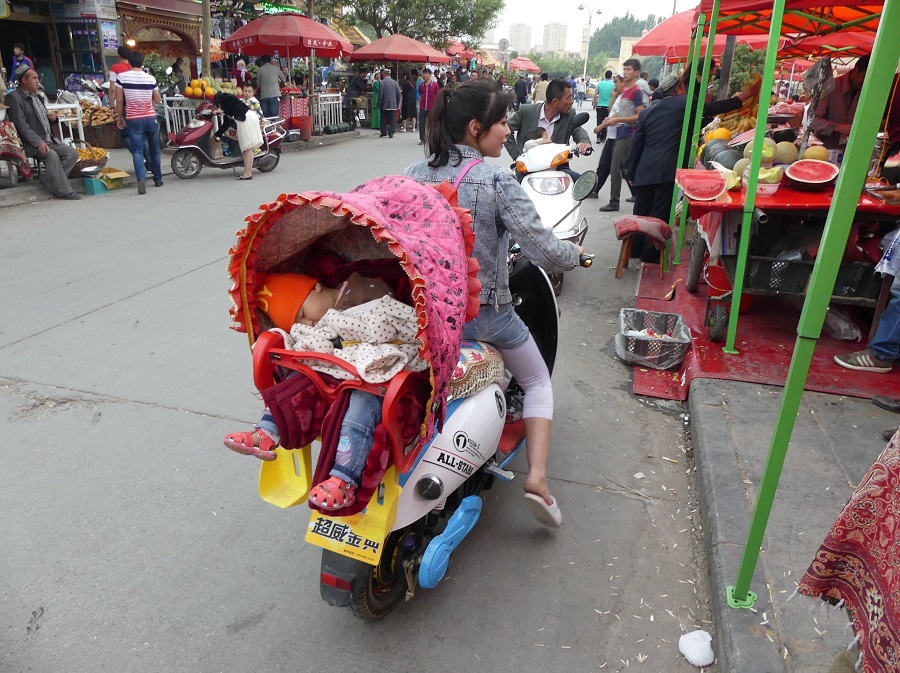 Kashgar night market for all to enjoy; with this little one taking a nap! Photo: Ali Karim. Copyright.
Kashgar night market for all to enjoy; with this little one taking a nap! Photo: Ali Karim. Copyright.
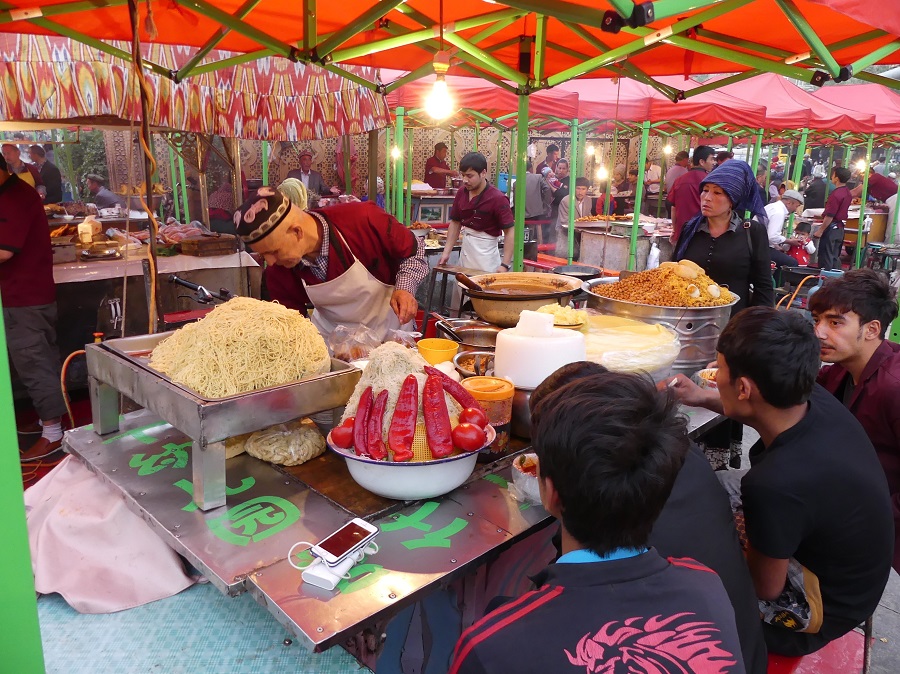 Kashgar’s night market serves local cuisine including Polo (Pilau), fish, chicken, and lamb kebabs. Photo: Ali Karim. Copyright.
Kashgar’s night market serves local cuisine including Polo (Pilau), fish, chicken, and lamb kebabs. Photo: Ali Karim. Copyright.
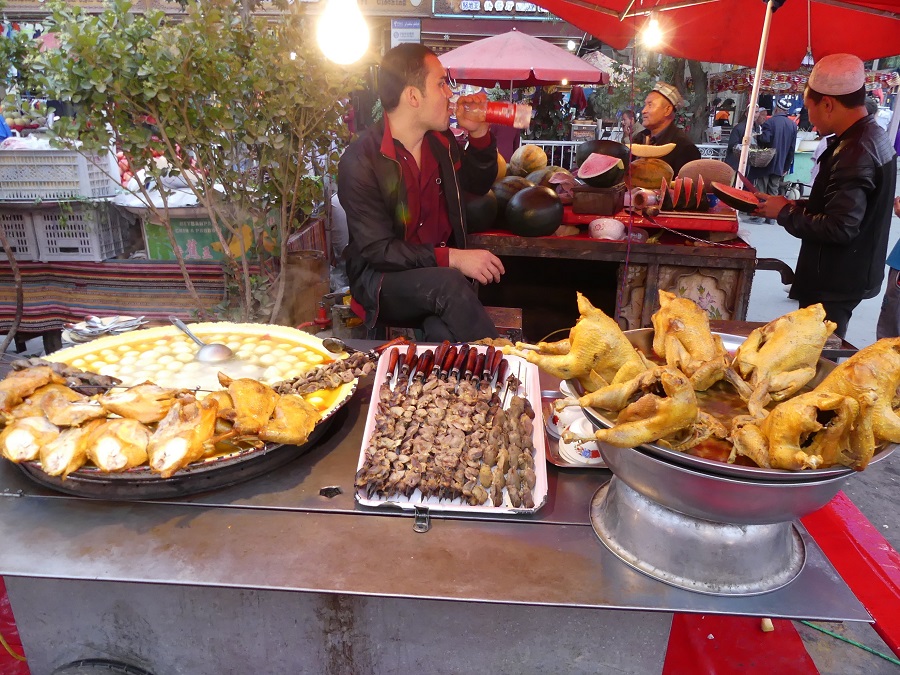 Kebabs and whole chicken, and melons! Photo: Ali Karim. Copyright.
Kebabs and whole chicken, and melons! Photo: Ali Karim. Copyright.
 To finish off the meal, a fresh watermelon! Photo: Ali Karim. Copyright.
To finish off the meal, a fresh watermelon! Photo: Ali Karim. Copyright.
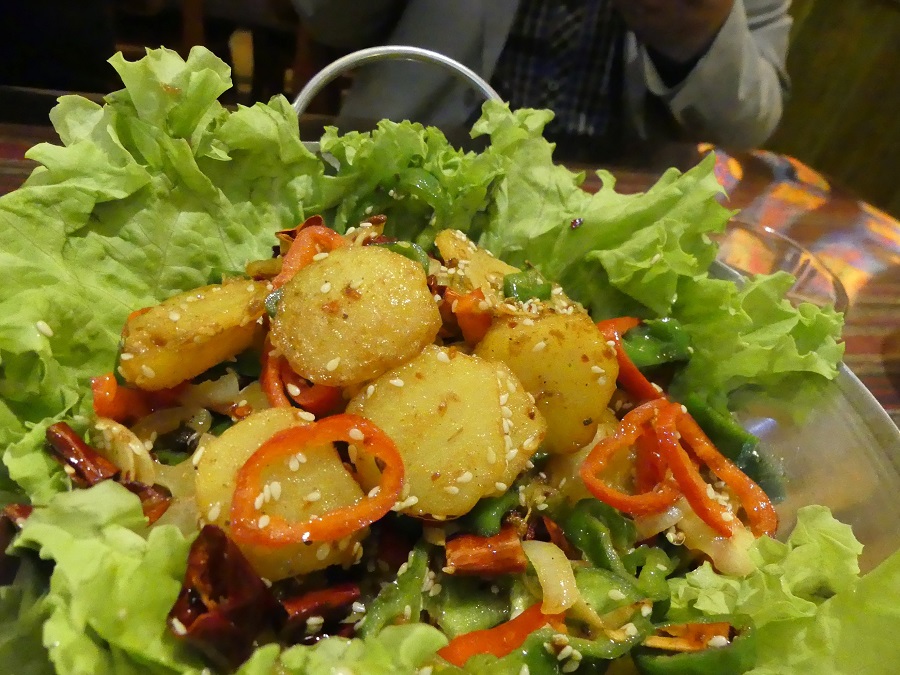 We decided to have dinner at a traditional Uyghur restaurant which had curtain-separated rooms for families and women. My favorite potato dish that I ordered was extremely hot and I had difficulty eating it! Photo: Ali Karim. Copyright.
We decided to have dinner at a traditional Uyghur restaurant which had curtain-separated rooms for families and women. My favorite potato dish that I ordered was extremely hot and I had difficulty eating it! Photo: Ali Karim. Copyright.
Next to us, was seated a nice Uyghur family, so I went over and greeted them with a salaam, and then shook hands with the father and then the mother. I was educated by Ablimit, our guide, that there are several things forbidden in the Uyghur culture:
- One is to NOT shake excess water from the hands after washing hands, so as not to spread dirty water everywhere;
- Another is never to shake the hand of a woman you don’t know; instead you simply put your right hand across your chest and bow slightly;
- Never blow your nose inside a Uyghur house; and
- Always take your shoes off at the door, when entering a Uyghur home.
Date posted: Saturday, November 5, 2016.
COPYRIGHT: This post is copyright by Ali Karim. Reproduction of material and photographs presented here without his prior written consent is strictly prohibited.
Forthcoming (week of November 7, 2016): Part 3 – More Kashgar and Tashkurgan.
_______________
We welcome feedback/letters from our readers. Please use the LEAVE A REPLY box which appears below. Please share this travelogue with your friends!
Did you miss the first installment in this highly anticipated series? Then please click Silk Road Travelogue by Ali Karim: (1) Shanghai, Urumqi and Turpan).
To learn more about Ali and Dilshad Karim’s interest in travelling, please click Contributors.
For a complete list as well as links to fantastic photo essays published on this blog please click on Table of Contents or visit the Home Page.
I was amazed to see mind bobling pictures – with very vivid discription of places. I admire your skill in photography and the art of writing. Its wonderful country and what we missed I saw in your pictures. I was in China with my wife on a guided tour and really enjoyed it. Going through all your pictures with its commentary gave me an urge to visit Humza Gilgit and other mountanious places and meet our Ismailies living there but probably it is too late in our life. Thank you for sharing your wonderful experience.
Zareentaj and Nooruddin
Terrific!
Thanks Nimat.
I am loving every word of Ali Karim’s Travelogue. Can’t wait to read part 3,4, 5, or as many parts there after! Compliments to both him and his wife.
Hi MH, Thanks for the nice comments; I really appreciate that. I am so happy that you have been enjoying my travelog. Soon, we will be in Hunza, and other areas of Northern Pakistan, which I know will be of huge interest to all Simerg subscribers. Please stay tuned 🙂
BY the way, part 3 is already on Simerg, at https://simergphotos.com/2016/11/14/silk-road-travelogue-by-ali-karim-iii-more-kashgar-and-spectacular-drive-to-tashkurgan/
Enjoy
So beautiful. In your next visit, My wife Fatma & myself would love to join you as we never travel alone!
Hi Akbarali and Fatma, thanks for the vote of confidence; so glad you enjoyed this 2nd episode of our trip. Traveling like we do is not for everyone, as we many times don’t get the comfort and the convenience we are used to. However, that pales in comparison to the great experiences we have travelling this way. There are times when things don’t go right for us too, which we have to take in stride and move on; chalking up the experience notch.
Please stay tuned, as we will soon get to Hunza, which was a most rewarding experience for us.
Thank you for sharing your entire tour with iconic photos of these regions which had been cut off from civilisation until our beloved mowlabapa developed the places.Truly reading through the account of your journey through Silk Road fascinated me and inspires me to make that journey.
Hi Daulat thanks for the nice words. It make my day to read that you and others have enjoyed reading my travelog. I highly recommend everyone to go to these more remote areas that are less touristy and fascinating to visit,
It is a pleasure to read your description and photos. You two took a long journey. We want to emulate you but hopefully from Gilgit. Will write and seek your advice. Where next for you two!
Hi Mohammed, So glad you enjoyed reading this travelog. Yes, please do reach out to me through Simerg.com; I will definitely give you best advice I can. I highly recommend everyone to do this trip; especially Hunza from Gilgit or from China like we did.
Next in the planning stages is Iran, followed by Turkmenistan and Uzbekistan. 🙂
Many thanks A. Karim, So beautiful photos and views in those places. I have been nearby, in Khorog along the Banj River in Badakhshan, not far from Kashghar. with lovely landscape.
Thank you again.
Hatim Mahamid
Palestine
Hello Hatim, thanks for the kind words. Glad you enjoyed the images.
Truly amazing pictures and commentary. Almost feels like we were there and seeing all the places through the lens of Ali’s camera. Very insightful post. It revealed a part of history and culture that we did not even know existed.
Mahamud, thanks for the kind words. I am very happy that you have enjoyed reading this. Stay tuned 🙂 for more experiences
Pingback: Silk Road Travelogue by Ali Karim: (II) More of Turpan and Historic Kashgar | gulzara